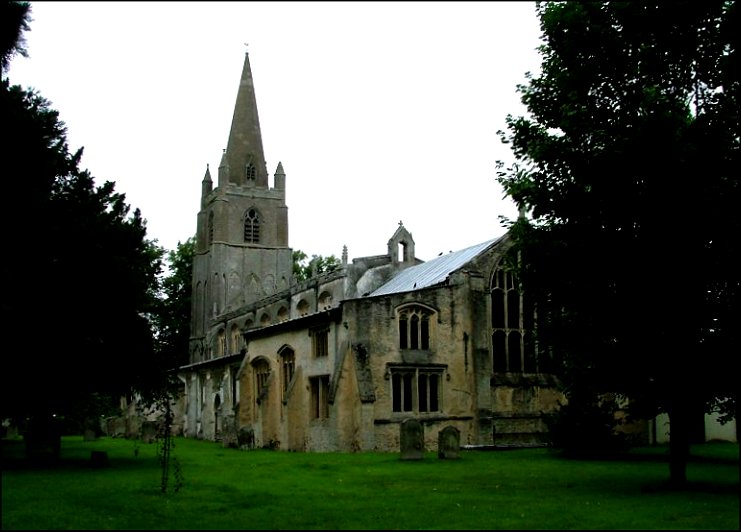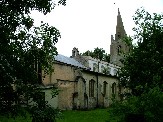
home I index I latest I glossary I introductions I e-mail I about this site
All Saints, Walsoken

Read
the captions by hovering over the images, and click on them to
see them enlarged.

| All
Saints, Walsoken The rectory, though beside the church, is in Cambridgeshire. The westwards graveyard extension is also in Cambridgeshire, and the sign shows that it is maintained by Fenland District Council. There is a path through to the old churchyard, and about ten feet to the west of the tower you enter Norfolk. Walsoken church is another architectural wonder, this time the biggest Norman church nave in East Anglia, with a magnificent Early English stone tower and later spire – this part of Norfolk is like an architectural textbook. If you stand in Cambridgeshire looking east, the western face of the tower is breathtaking, a Norman doorway flanked by Early English arcading. In the 15th century, the aisles and clerestory were added or elaborated, and even the porridge-like cement rendering can't detract from its grandness. But inside, the Norman takes over. The long round-headed arcades are superb, climbing into the chancel in one direction and disappearing under an exquisitely beautiful EE tower arch in the other. Never has Norman looked so elegant. And this is the setting for one of the most wonderful art objects in Norfolk – the Seven Sacrament font. This was what we had come to see, we hadn’t really come to sacrifice goats.
Anti-clockwise from the eastern face, the panels show Mass (the Priest elevating with his back to the viewer), Confession (the figures similar to West Lynn, but finely detailed, and the Confessor clearly male), Confirmation (including babes in arms, as is usual in Norfolk), Baptism (again as at West Lynn, the baby being immersed head first), Crucifixion as the eighth panel, Last Rites (quite a gathering around the dying man), Matrimony (the bride daintily lifts her skirts in her left hand) and Ordination, the Bishop holding his crozier as he touches the Deacon). You can see all these images enlarged below. The panels are relatively unvandalised; probably, the shallowness of the reliefs allowed them to be plastered over by the reformers without them being knocked flush. Around the shaft are elegant Saints: John the Baptist, Dorothy, Peter, Catherine, Paul, Margaret, Stephen and Mary of Magdala, a thoroughly orthodox selection typical of the eve of the Reformation. Finally, around the base is a dedicatory inscription asking us to pray for the immortal souls of S Hoynter and Margaret his wife and John Beforth chaplain. It is punctuated by little shields carved with the Instruments of the Passion. As I so often say, if this was in the V&A we would all hurry down to London to see it, paying handsomely for the privilege; but here it sits in the suburbs of a fenland town, still in use and there for all to see. In the 18th century, someone in this parish seems to have had an obsession with the Judgement of Solomon – this is depicted as a wallpainting at the west end, with a wooden statue of the man seated in judgement, and there are four paintings of the same subject hanging in the chancel. A statue of David with his harp hangs incongruously above the chancel arch. It was actually quite fascinating to see reminders of that century's obsession with the Old Testament; so often, the Victorians were embarrassed by it, and did their best to replace it with loud medievalisms. There are a good number of surviving medieval bench ends, but they are all mutilated. They appear to show seated figures, and may be any number of things. They've been claimed as Saints, but I think they may be part of a Seven Deadly Sins series - one of them is determinedly masculine, with his legs spread, his cloak open and his genitalia curiously unvandalised. He may be lust, and the one who appears to hold a sword would then be Anger rather than St Paul. There are standing figures in arcades on the side of the bench ends as at two of the Wiggenhall churches, similarly vandalised, presumably in the 16th century. There is more old woodwork up in the chancel in the form of stalls. These have heads on them, battered rather than vandalised this time; the Bishop in his mitre is particularly good.
About this time, one of the churchwardens came in and chatted to us. He was a lovely man, genuinely interested in his church and also interested in what we thought of it. I am afraid that I can bore for England about Seven Sacrament fonts, but he listened cheerfully, and so I put the Rector's earlier taciturn briefness down to his being unusually busy - probably, he was halfway through writing his sermon for tomorrow. This is one of the most interesting churches of the Norfolk marshes – perhaps just beaten by Walpole St Peter, but the font here is the best single thing I saw all day, and joins my growing list of East Anglia's finest church art objects. Lets hope the V&A doesn't get to hear of it. Simon Knott, July 2005 |
Amazon commission helps cover the running costs of this site.
home I index I latest I introductions I e-mail I about this site I glossary
links I small
print I www.simonknott.co.uk I www.suffolkchurches.co.uk
ruined churches I desktop backgrounds I round tower churches